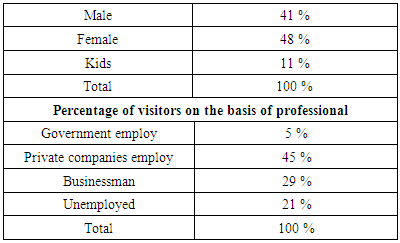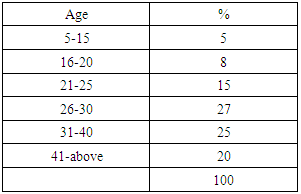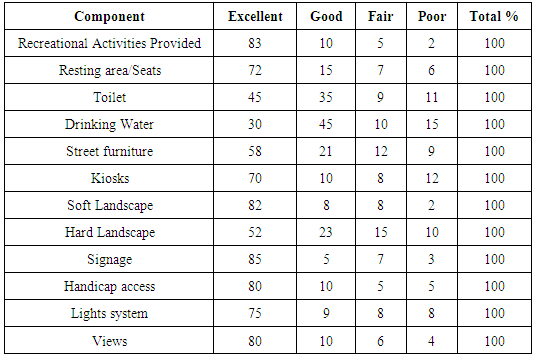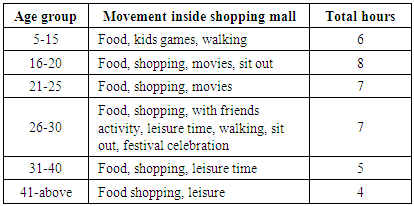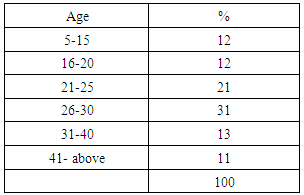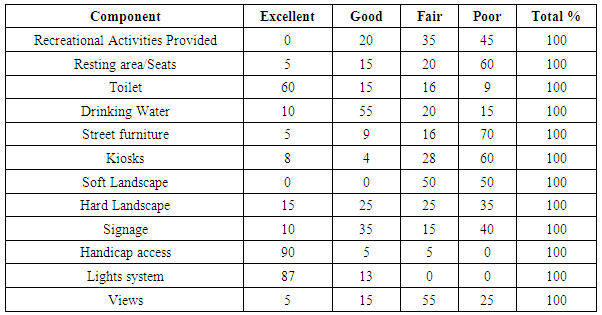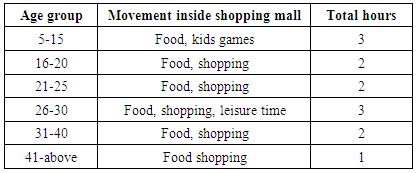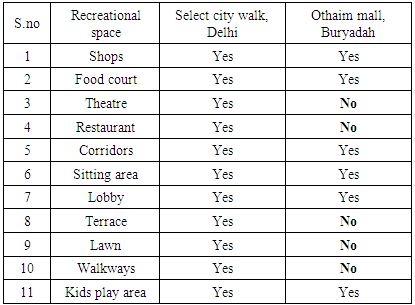-
Paper Information
- Paper Submission
-
Journal Information
- About This Journal
- Editorial Board
- Current Issue
- Archive
- Author Guidelines
- Contact Us
Architecture Research
p-ISSN: 2168-507X e-ISSN: 2168-5088
2016; 6(1): 21-28
doi:10.5923/j.arch.20160601.03

Integration of Recreational Spaces within Othaim Shopping Mall, Buraydah, Saudi Arabia
Mohammed Aish Al Marwaee (Dean)
College of Architecture and Planning, Qassim University, Buraydah, Saudi Arabia
Correspondence to: Mohammed Aish Al Marwaee (Dean), College of Architecture and Planning, Qassim University, Buraydah, Saudi Arabia.
| Email: |  |
Copyright © 2016 Scientific & Academic Publishing. All Rights Reserved.
This work is licensed under the Creative Commons Attribution International License (CC BY).
http://creativecommons.org/licenses/by/4.0/

In the past, shopping mall originated for the purpose of shopping, currently recreational function integrating day by day in shopping mall. While recreational demand is changing with users, time, culture & social environment. However shopping mall’s components like; soft and hard landscape zones, open spaces, courtyards, corridors, galleries are demanding for the transformation and modification as per the national and international user’s demand at this time. Recreational spaces cover lots of potential to full fill the recreational changing demands of users. In this study, we will study shopping malls; how they are integrating recreational activity for national and international users, additionally will categorize the user’s behavior and satisfaction. At last, we will discover the recreational demand; accordingly will propose recreational activities to increase the recreational efficiency of Othaim Mall, Buraydah.
Keywords: Shopping mall, Open spaces, Recreation and leisure, Courtyard, Entertainment, Food Court, Indoor outdoor activity
Cite this paper: Mohammed Aish Al Marwaee (Dean), Integration of Recreational Spaces within Othaim Shopping Mall, Buraydah, Saudi Arabia, Architecture Research, Vol. 6 No. 1, 2016, pp. 21-28. doi: 10.5923/j.arch.20160601.03.
Article Outline
1. Introduction
- Al Qassim region located almost in the center of Saudi Arabia, according Wikipedia its population is 1370727. Qassim is famous for its agricultural land and greenery. Qassim region is the one of the richest region of Saudi Arabia. Buraydah is the capital of Al Qassim region and it is approximately 400 km far from Riyadh region. Neighbor cities come here to get benefit of leisure and entertainment. Buraydah every year organized festivals, events and celebrations, masses of people attract here for this reason also. To enjoy short vacation various Saudi families come here. Buaydah recreation includes entire activities which makes people stress free. Buraydah culture, social circumstance, fast life and lots of pressure of the work have created the necessity of recreation in the individual life. Recreational activities time by time innovate by designer and assimilate with building to serve the users. Shopping mall is the paramount building choice to grant recreational movement in Buraydah. Here are the amenities of entertainment, eating, kids play area and other various entertainment sources. Shopping mall is the preferable entertainment place for families where most of the types of recreation stay alive which does not affect Islamic law. Unfortunately, today shopping mall is not serving various services to customers as national and international visitors come here. Limited people visit mall for shopping, hangout, leisure, recreation, meeting with friends. Few visitors come to enjoy mall luxury and beautiful interior, apart from that number of visitors are not increasing.
2. Literature Review
- Shopping mall, Its cultural significance is evidenced by the considerable time and energy consumers devote to the endeavor (Graham 1988; International Council of Shopping Centers 1990), it participate in a wide range of experiential activities in order to satisfy various personal and social motives (Bloch, Ridgway, and Dawson 1994; Morris 1987; Tauber 1972). shopping is a form of recreation and entertainment that may even be one of their favorite pastimes and a preferred activity of choice (Gonzales 1988; Hughes 1989).Consumers of all ages spend more time in shopping malls than anywhere else except home, work, and school (Kowinski 1985; Stoffel 1988), many consumers truly enjoy being in the marketplace to make a product purchase and/or engage in experiential consumption (Bloch et. al. 1994; Campbell 1997a; Prus and Dawson 1991; Solomon 1996). Customers attract towards shopping mall for shopping purposes and entertainment purposes also. Similarly, Customer satisfaction is defined as "the number of customers, or percentage of total customers, whose reported experience with a firm, its products, or its services (ratings) exceeds specified satisfaction goals." (Ferris et al., 2010; Tse and Wilton, 1988; Oliver 1999). Secondly said by Kim, et al., (2004) customer satisfaction is customer’s reaction to the state of satisfaction, and customer’s judgment of satisfaction level. Various factors affect to make successful any shopping mall. Like , The factors which are affecting to customer to shopping in selecting the shopping place fall in five groups i.e. Features of price, accessibility, environment, mall image, regarding the consumer buying behavior, convenience and rewards (Wong et al., 2012; Dawar and Parker, 1994;). Apart from that, A research done by Wang & Ha, (2011), nine features of mall make significant the consumer to loyal towards shopping in mall that are mall atmosphere, after sale service, brochures and pamphlets, communication, convenience, quality and assortment of products promotions, expected behavior and rewards as discounts etc. Shopping mall requires cultural effect to attract people. Merchandise price, income of the consumers & culture also had some impact on the failure cause of malls Ambavale (2013). Consumers evaluate the malls on the basis of products and different features of mall e.g. location, employees and atmosphere, Manana, (2009). Customer demand and expectations are very important to understand, Each and every region people demands does not match. Obeja and Bedia (2012) said that customers are conscious about extra facilities & service provided by personal selling in shopping malls. Now a days, tourist also visit in shopping mall and enjoy there, designer should keep in mind that shopping mall should keep some tourist attraction features so that tourist stay in shopping mall as much as possible. Length of stay is one of the key elements in a tourist’s decision-making process (Bull, A. 1995).Determined other dimensions of mall selection behavior e.g. decoration, atmosphere, exterior and cleanliness of mall (Newberry et al., 2003).Differed levels of product assortment affect consumer purchasing behavior more than prices (Fox et al., 2002).Shopping mall has a very significant value for social issues through open spaces, which allows people to socially interact. Play spaces should provide opportunities for social interaction, which develops an individuals’ ability to work in groups, share, negotiate, cooperate, resolve conflicts and learn self-advocacy skills (Ginsburg, 2007; Hudson &Thompson, 2001). Similarly, Play can also stimulate emotional and social states, such as empathy and self-regulation, known as emotional intelligence, which is vital for successful future relationships (Goleman, 1996). Through the open spaces and play opportunities in the shopping mall, socially people integrate more and more and connect deeply. The play space design should enable socialization to occur, through allowing enough space for interaction when desired but also providing safe areas in which to retreat until confidence and self-assurances developed (Heseltine & Holborn, 1987). Landscape plays a very important role in the success full design of shopping mall. Landscape is ‘‘a way into a foundation for the exploration of all that there is—the social totality within which we live’’ (Mitchell, 2008, p. 47).
3. Objective
- Ÿ Increase the spending hours of visitor’s in Othaim mall, Buraydah.Ÿ Investigation of user’s satisfaction level & recreational infrastructure of Othaim mall, Buraydah
4. Methodology
- For the understanding of shopping mall relationship with users, conducted detail interviews. In this process, first of all interviewed the visitors of Select City Walk which has incorporated various recreational activities at urban level according local and international visitors, users are escalating day by day. Interview questions decided according objective of the study. Interview held on 22 November 2015, Sunday with all age group visitors. That analysis helped to find out the infrastructural, planning issues, social issues of mall due to which people are attracting as much as. Secondly, interviewed in Othaim Mall, which is the main focused area of this study. Accordingly, asked about user’s profile, this interview held at 21th December 2015, Monday. Analyze the activity patterns of all age group, likes & dislikes and recreational demand through site visit also. Data also collected from research papers, journals, magazines, internet, site visit, discussion with visitors. Finally, compared both shopping mall and comprehend all differences. Additional recreational activities find out from analysis, while integrate in the existing Othaim mall will become the cause of increasing the number of national and international visitors. The image of Othaim mall will improve for visitors and will change the scenario of providing entertainment sources. All nationality visitors will be able to get relax according their expectations through integration of suggested recreational activities within the mall.
5. Case Study -1
5.1. Select City Walk
- Select city walk is located in the capital of India, New Delhi. It prides itself is being located within India's most affluent, high-end urban & cosmopolitan catchment area, South Delhi, as shown in Figure no 1. The locality being the prime residential hub of the city, offers a catchment population of over 1 million SEC A&B consumers (of a total catchment population of over 1.7 million). An overwhelming majority of the Capital's high-net worth individuals and families live and shop in South Delhi, while almost all the city's key retail micro markets and high-streets are located in this part of Delhi. GK- M Block, Ansal Plaza, South Extension, Basant Lok & Khan Market, are all thriving on South Delhi's rich catchment population.
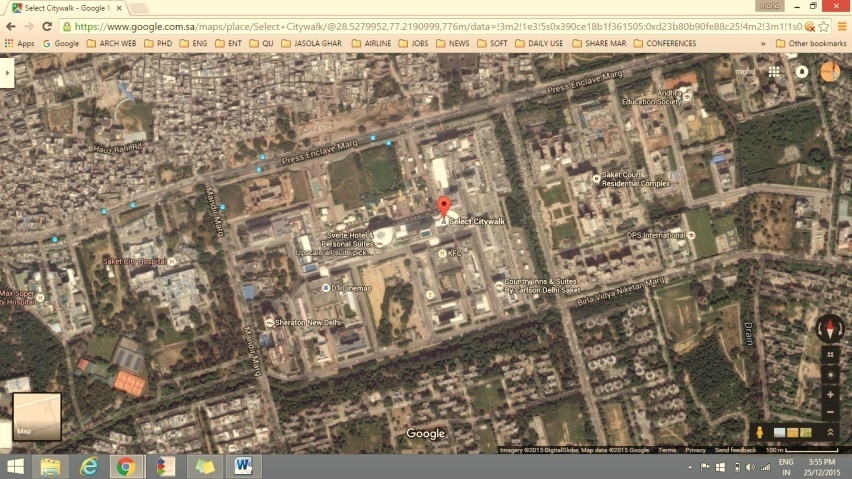 | Figure 1. Location of Select City walk |
5.1.1. Design & Planning
- Multiplex embodies the luxurious amenities of the modern day cinema, the multiple screen choices, state-of-the-art technology, ergonomic seating, eye-catching architecture, and top of the line concessions, restaurants, and food courts. Integrating shopping with cinema to generate better opportunities and making it lucrative. To compete with already existing cinema, the proposed cinema complex has to provide better facilities in terms of viewing, comfort, interiors and other facilities like parking, public convenience, etc. Building is creating an identity with special architectural interest, which would enhance the built fabric of the city. The entire cinema building is designed after studying the traffic patterns and keeping in mind the integrity with the mall building. The cinema building consists of six cinemas. Two of them are Gold Class cinemas catering to high net worth individuals and families. The other four cinemas start from first floor level and stacked over the Gold class cinemas. The main entry as given in control drawings is through a bridge which connects the cinema and the mall building at first floor level. In addition the ground floor entry is utilized to give the entries to Gold class cinemas and the cinemas above. The lot of attention has been paid in drawings the peoples from the cinema towards the main meal which would combine the joy of shopping and watching the movie in the same complex.Recreation encompasses all the activities that enable people to unwind and relax themselves. Changing lifestyle and tremendous work pressure have transformed recreation into a primary need. Its parameters have got redefined in the urban setup. Various forms of recreation either active or passive have with them got associated with various buildings to provide entertainment, etc. The fast emerging mall culture has felt a strong impact of this integration of recreation activities. With the world movement of smart growth focus on entertainment, eating & recreating has increased. People go to malls not only for shopping but to hang out, for leisure or simply find it as a meeting place. People frequent malls to see them and to enjoy the air-conditioned luxury. A common feature of shopping malls is a food court which is typically comprised of a number of fast food vendors of different types, surrounding a shared seating area. Figure no 2, parks offering various forms of entertainment, such as arcade games, carousels, roller coasters, and performers, as well as food, drink, and souvenirs. Some amusement parks or theme parks are designed with shopping mall to attract more people.
 | Figure 2. Views of Select City Walk |
5.1.2. Visitor’s Analysis
|
|
5.1.3. Recreational Infrastructure Analysis
|
|
5.1.4. Visitors Spending Hours
|
6. Case Study – 2
6.1. Othaim Mall, Buraydah
- Othaim mall is located in the center of Buraydah, Al Qassim as shown in figure no 3. In the surrounding of the mall is residential area as well as commercial area also. Mall keeps almost 320 retail stores, food chains, kids ‘entertainment zone, hypermarket etc. Here is the wide variety of products like clothing brand, household items, jeweler and other also.
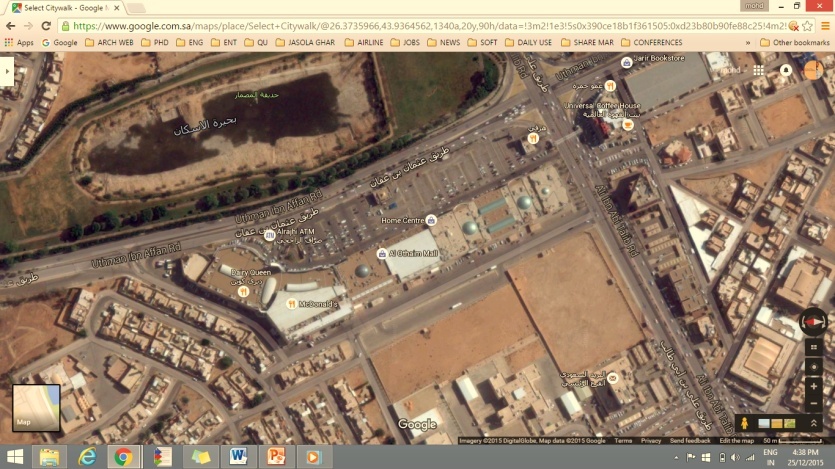 | Figure 3. Location of Othaim Mall |
6.1.1. Design & Planning
- Here is not ticket price for any activity. It opens Saturday to Thursday from 9:30 am till 12 pm and after lunch from 4pm till 11pm in the night, Friday it opens from 4pm till 11pm. specially, it is completely family shopping mall, and most of the shop allows for families, single male does not allow in particular shop. Male and female are allow for prayer on the first floor separately of the mall. Kids play area is very near from prayer area so that kids can play alone also. On the both sides of the mall is a huge parking space and it also keeps parking in basement also shown in figure no 4.
 | Figure 4. Aerial view of Othaim Mall |
6.1.2. Visitor’s Analysis
|
|
6.1.3. Recreational Infrastructure Analysis
|
|
6.1.4. Visitors Spending Hours
|
7. Infrastructural Analysis
|
8. Results and Conclusions
- Saudi Arabia has its own culture and social system which is the backbone of the society. Society is accepting new technology and advancement, Muslim society does not allow to overruling the Islamic rules. Accordingly, Shopping mall is the building which designed lavishly, where different nationality people are coming and sharing their cultural values to make it very special visit and surprised to stay inside the mall. Saudi Arabia offering jobs to other nationality people from last many years, they are the part of this social gathering. Shopping mall should incorporate more and more recreational spaces inside the building especially for women and kids where any man cannot enter. These spaces should redesign according new technology and advancement for better motivation and enjoyment. Open space must be provided in the shopping mall so that women and kids play and can enjoy the recreation activity with ambient leisure which designed according Islamic system. Separate open spaces should provide for bachelors and old people to making a balance of mind so that they can become the part of the shopping mall’s crowd. Finally, Shopping mall requires a refine zoning with new technology and advancement, which fulfill the entire recreational demand of all age groups.
 Abstract
Abstract Reference
Reference Full-Text PDF
Full-Text PDF Full-text HTML
Full-text HTML